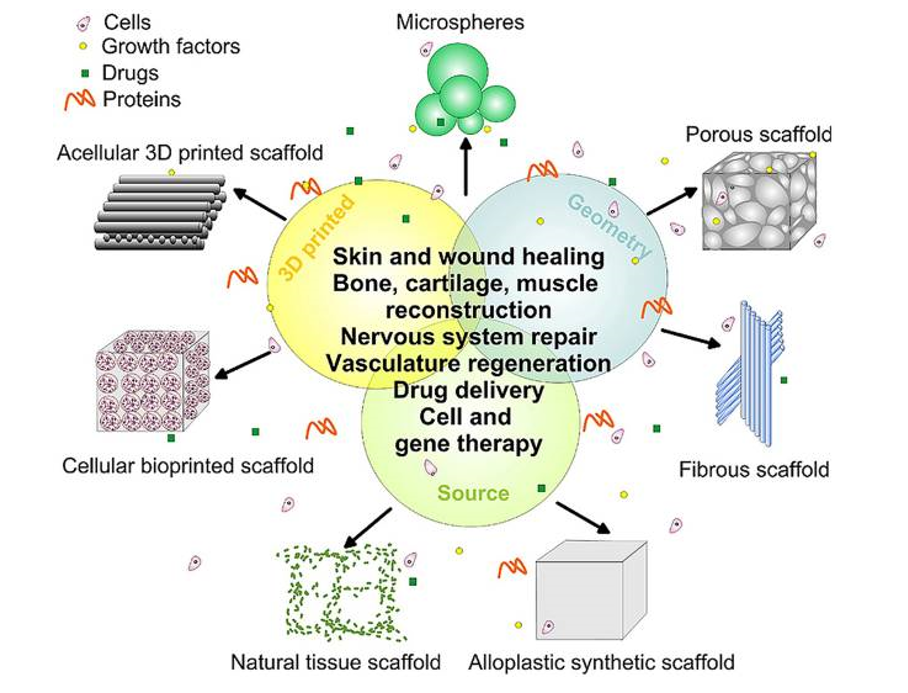Tissue Engineering
Tissue engineering and regenerative medicine (TERM) is an emerging biomedical field. In TERM, three-dimensional (3D) printed scaffolds are used for biomedical purpose. These 3D-scaffolds are biomaterial complex which act as support for cell growth, development and formation of complex tissue structure. Though, the ideas and strategies of TERM are simple in concept but have been proven as a challenge. There are different kinds of materials used for constructing 3D-printed scaffolds based on their chemical composition and other properties. These scaffolds are used in-vitro processes to learn about their use, side effects and how they support the cell growth and tissue regeneration. Once these scaffolds show some promises in vitro, these are used in invivo studies to learn in detail about their actual behavior in living system.

Figure 1: General types of 3D-Scaffolds and their use (Source: Nikolova and Chavali, 2019)
Biomaterials in Tissue Engineering and Regenerative Medicine
Although, the 3D scaffolds are generally being used for reconstruction or restoration of anatomical parts and functional tissues, these can be used as entirely as supporting structures. These scaffolds acts as the template for tissue regeneration process by providing the surface for cell attachment, proliferation, generation of extracellular matrix, bone growth and development, muscles, nerves and blood vessels restoration. Therefore, materials used are for making 3d-scaffolds are ceramics, metal, composite materials, natural and synthetic polymers.. There are certain properties of these materials which makes them suitable for use in 3D-scaffold. These includes phyiocochemical nature (porosity, biodegradation, surface chemistry, etc.) and mechanical properties (elasticity, plasticity, stiffness, etc.) including commercial feasibility and sterilization.

Figure 2: An overview of Graphene 3D scaffolds in used in tissue engineering (Source: Geetha et al, 2019)
Since, every biomaterial do not all need, there scaffolds are made up of different materials. Ceramics are suitable for hard tissue replacement and orthodontic applications whereas natural polymers like proteins (collagen, gelatin, keratin, silk, etc) and polysaccharides (ceullulose, chitin, hyaluronic acid, chitosan, etc) are used for generation of connective tissues, drug delivery including other soft and hard tissue applications. Similarly, the metals and alloys (copper-chromium, titanium, stainless steel, etc) are used for dental and orthopaedic applications. Composities are also used for orthopaedic and dental application. All of these materials have their own pros and cons. They have their own process of printing. Now days, most of the research focuses are on developing the biomaterials which are easier to print, enhance cell viability and cell proliferation.
References
- Recent advances in biomaterials for 3D scaffolds: A review. Nikolova Maria P. and Chavali Murthy S (2019).
- Graphene-based 3D scaffolds in tissue engineering: fabrication, applications, and future scope in liver tissue engineering. Int J Nanomedicine. 2019Geetha Bai R, Muthoosamy K, Manickam S, Hilal-Alnaqbi A (2019). https://doi.org/10.2147/IJN.S192779
- Scaffolding Strategies for Tissue Engineering and Regenerative Medicine Applications. Sandra Pina, Viviana P. Ribeiro, Catarina F. Marques, F. Raquel Maia, Tiago H. Silva, Rui L. Reis and J. Miguel Oliveira (2019).